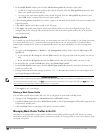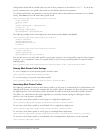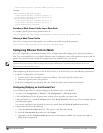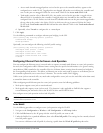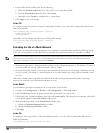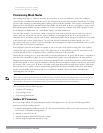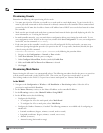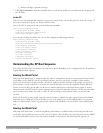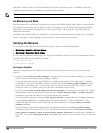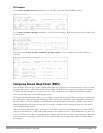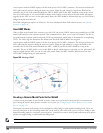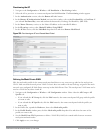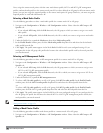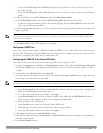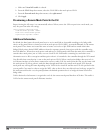
470 | SecureEnterpriseMesh DellPowerConnectW-SeriesArubaOS6.2 | User Guide
applicable, is similar to that of a thin AP. Remember, the priority of the mesh point is establishing a link with
neighboring mesh nodes, not establishing a control link to the controller.
NOTE: In a single hop environment, the mesh point establishes a direct link with the mesh portal.
Air Monitoring and Mesh
Each mesh node has an air monitor (AM) process that registers the BSSID and the MAC address of the mesh node
to distinguish it from a thin AP. This allows the WLAN management system (WMS) on the controller and AMs
deployed in your network to distinguish between APs, wireless clients, and mesh nodes. The WMS tables also
identify the mesh nodes.
For all thin APs and mesh nodes, the AM identifies a mesh node from other packets monitored on the air, and the
AM does not trigger “wireless-bridging” events for packets transmitted between mesh nodes.
Verifying the Network
To view a list of your Mesh APs via the WebUI, navigate to the one of the following windows:
l Monitoring > Network > All Mesh Nodes
l Monitoring > Controller> Mesh Nodes
To view mesh APs and the mesh topology tree using the command line interface, access the command-line interface
in enable mode and issue the following commands:
l show ap mesh active
l show ap mesh topology
Verification Checklist
After provisioning the mesh APs, follow the steps below to ensure that the mesh network is up and operating
correctly.
l Issue the command show ap mesh topologyto verify all the mesh APs are up and the topology is as expected.
(Wait 10 minutes after startup for the topology to stabilize.)
l Verify each mesh node has the expected RSSI to its neighboring mesh nodes. The mesh topology is updated
periodically, so access the command-line interface and issue the command show ap mesh neighbors for the
current status. If the RSSI is low, verify that the tx-power settings in the mesh node’s 802.11a/802.11g radio
profiles are correct, or, if ARM is used, verify the correct minimum tx-power setting.
l Issue the command show ap mesh debug provisioned-clustersto verify that the mesh clusters are correctly
defined and provisioned (with encryption if desired). Issue theshow running-config | include recovery
command to verify that the cluster’s recovery profile matches the controller's.
l Verify antenna provisioning by issuing the show ap provisioning command and verify installation parameters
for non-default installations (e.g. standard indoor APs deployed outside, or W-AP85 and W-AP175 Series
outdoor APs deployed inside.). Ensure all APs use the same channel list by issuing the show ap allowed-
channels command.
l
If the mesh-radio is to be reserved exclusively for mesh backhaul traffic,
issue the show ap profile-usage
command to identify the radio’s 802.11a or 802.11g radio profile, then issue the command show rf dot11a-
radio-profile <profile> or show rf dot11g-radio-profile <profile> to verify the radio is disabled in
the profile. Next, use the show ap bss-table command to that verify no access Virtual APs are up on the mesh
radio.



